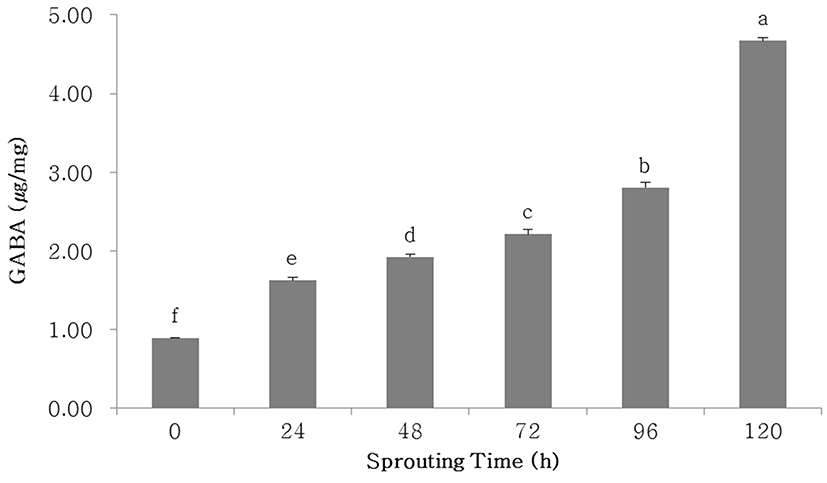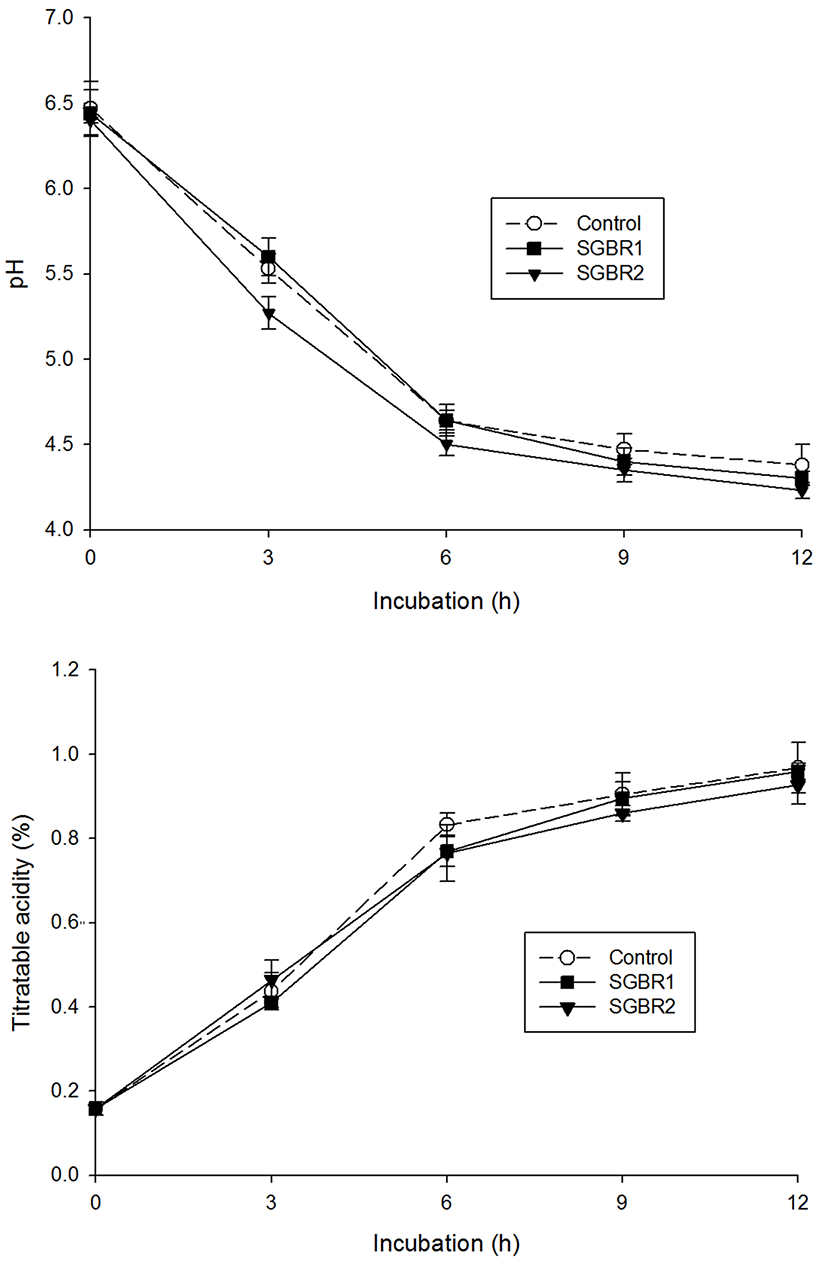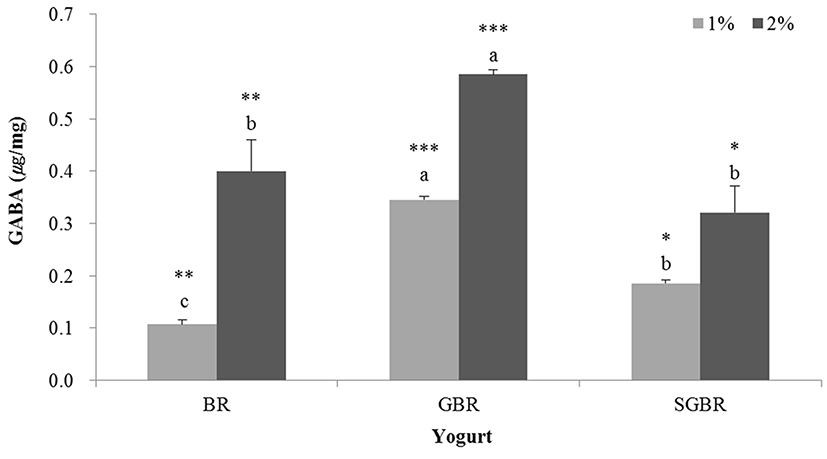Introduction
Generally, yogurt is defined as mammal milk fermented using lactic acid bacteria (LAB), yeast, or all of them, as a starter. It is manufactured as a beverage with or without additional flavors, such as fruit (Lim, 2007). It contains lactic acid, peptone, peptide, and oligosaccharides and is widely known to improve health through intestinal regulation by multiplication of LAB (Gilliand, 1989). Recently, as the awareness regarding health has increased, many people are more interested in the effect of diet on their health. As various healthy foods are in demand (Kang et al., 2006), fermented milk containing added functional material has been studied.
Whole grain is recognized for its nutritional superiority because it contains embryo and bran, which have various nutritional and bioactive compounds (Jones et al., 2002). Many nutritionists recommend consuming whole grains, rather than refined ones. Hence, the size of market for whole grain products is on a rise, in response to the demand of consumers for healthy products (Baek, 2003). Brown rice (BR) is an important source for dietary fiber. It can supply twice the amount of dietary fiber than polished rice (PR), and contains high amounts of good vegetable protein, fat and minerals such as calcium, phosphorus, sodium and iron (Lim, 2008). Although BR has an outstanding effect, many people prefer PR because of its cooking ease and superior texture. To overcome these problems of BR, germinated brown rice (GBR) has been introduced (Kum et al., 2004).
Sprouts of approximately 1-5 mm, germinated from BR at suitable temperature, moisture level, and oxygen concentration, is called GBR (Jang, 1998). It has been reported that GBR has cholesterol and blood pressure lowering effect (Kang et al., 2006; Madar, 1993). GBR shows improved characteristics in terms of cooking and texture, compared to BR, and is rich in functional compounds such as γ-aminobutyric acid (GABA) and γ-oryzanol that are generated or increased during germination. In addition, its mouthfeel, digestion, and absorption in the intestine are improved by free sugars, such as glucose or oligosaccharides, generated from starch hydrolysis during germination. Thus, GBR is improved, not only in functionality, but also in palatability and convenience, compared to BR (Kim et al., 2006; Sasagawa et al., 2006). In addition, it is known that most grains have an antinutrient factor, such as phytate. However, the phytate is decompounded, during geminating of BR, into phosphoric acid and inositol, which are converted into energy (Larsson and Sandberg, 1995; Liang et al., 2008). In view of these facts, it is considered that fermented milk supplemented with GBR could show functional properties such as, cholesterol and blood pressure lowering effect and intestinal regulation, and it could be good for children, but also elderly people. Therefore, this study was carried out to determine characteristics of fermented milk supplemented with GBR, which contains the bioactive compound GABA and changes in the functional ingredients by lactic acid fermentation.
Materials and Methods
The BR was used in this experiment was harvested in Jeongeup, Korea, and processed in an agricultural cooperative in 2010. The yogurt starter used in this experiment was a mixed commercial culture, YC-X11 (Chr. Hansen, Denmark), and it contained Lactobacillus bulgaricus and Streptococcus thermophilus. Enzymes producing saccharified germinated brown rice (SGBR) were α-amylase (ADN 04260, novozymes, Denmark), which originated from Bacillus amyloliquefaciens, and β-amylase (AMS30032, Novozymes, Denmark), which originated from Aspergillus niger. They were used for liquefaction and saccharification of GBR, respectively. Reagents to analyze the functional properties of GBR and fermented milk, such as methanol (99.9%), n-heptanes (99%), benzene (99.9%), 2,2- dimethoxypropane (98%), 2-mercaptoethanol (98%), potassium borate (99.5%), and phthaldialdehyde, were purchased from Sigma-Aldrich Co. (USA).
GBR was germinated by soaking BR, after washing with distilled water (DW). The soaking solution was kept 30℃ and exchanged with a fresh solution at 12-h intervals. Additionally, a bubble generator (A-250, Amazonpet, China) was used to maintain the freshness of the soaking solution. SGBR was prepared as follows: 20 g GBR was mixed with 100 mL DW, and gelatinized at 80℃ for 10 min. Then, 0.1 mL α-amylase was added, and the mixture was incubated for 1 h. After calibrating pH of the liquefaction into pH 4.8, 0.1 mL β-amylase was added and saccharified at 60℃ for 1 h. BR and GBR samples were prepared by lyophilization with a freeze dryer (FD-1000, Tokyo rikakikai Co., Ltd., Japan), and breaking into 60 mesh size.
One or two percent (w/v) of the samples (BR, GBR and SGBR) were mixed with skim milk powder to make 12% solid content of skim milk, pasteurized at 95℃ for 15 min, and cooled to 37℃. Successively, approximately 3% of the successive cultured commercial yogurt starter (YC-X11, Chr. Hansen, Denmark) was inoculated in the skim milk and fermented at 37℃ for 12 h. Titratable acidity, pH, and LAB count were measured every 3 h, and fatty acid and GABA contents were analyzed after 9-h fermentation.
Fatty acids were extracted according to the procedure by Garces and Mancha (1993). Briefly, 0.5 g freeze-dried sample was mixed with 5 mL of methanol:heptane:benzene:2,2-dimethoxypropane:H2SO4 (37:26:20:5:2, v/v) mixture, and filled with nitrogen gas. First, the mixture was heated at 80℃ for 1 h, and fatty acids were extracted after stirring. Secondly, after heating and stirring for 15 min, it was extracted in the same way. The extracted supernatant was analyzed with GC, and the analysis conditions are shown in Table 1.
To analyze fatty acid of fermented milk, the sample, which was lyophilized after 9-h fermentation, was used for fatty acid extraction. Fatty acid analysis of fermented milk was also carried out according to the modified procedure by Garces and Mancha (1993), similar to the fatty acid analysis of the grain samples.
GABA contents of BR, GBR, and fermented milk supplemented with BR, GBR, or SGBR were analyzed according to the modified procedure by Oh and Choi (2000). Two hundred milligrams of sample were mixed with 800 μL of methanol:chloroform:water (12:5:3) mixture, and the primary supernatant was collected by centrifugation (12,000 g, 15 min, 4℃) after stirring and extracting for 30 min. Eight hundred micrograms of chloroform:water (3:5) mixture was added into the precipitate for secondary extraction of remnant GABA, under the same conditions of centrifugation as for the primary extraction. The primary and secondary supernatants, collected after centrifugation, were mixed and lyophilized. Two milligrams of distilled water was added to the lyophilized sample, and filtered with 0.45 μm membrane filter. The filtered sample was mixed with equivalent O-phthaldialdehyde (OPA), and analyzed using HPLC (Table 2).
pH of the fermented milk was measured using a pH meter (pH meter 445, Corning Inc., USA). To measure titratable acidity, 10 g sample was mixed with 10 mL DW, and titrated to pH 8.3 with 0.1 N NaOH (factor=1.001). The amount of NaOH injected during the titration was converted into amount of lactic acid.
One milliliter of the sample was mixed with 9 mL of 0.1% peptone, and diluted using the ten-fold dilution method to count LAB. Subsequently, 1 mL aliquot was transferred to a plate, and MRS agar (Becton, Dickinson and company, USA) was poured into the plate, and incubated at 37℃ for 48 h. The standard plate count method was used to enumerate the bacteria, wherein the number of colonies was multiplied by the dilution factor and reported as the number of colony forming units (CFU) per gram of sample.
Results and Discussion
Table 3 shows fatty acids composition of the grain samples. Major fatty acids in all grain samples such as PR, BR, GBR, and SGBR were palmitic, oleic, and linoleic acid. Linoleic acid constituted the highest portion of the fatty acids at 32.13%, and palmitic acid and oleic acid were 25.98% and 24.04%, respectively, in PR. The fatty acid compositions of BR were 35.65% linoleic acid, 34.13% oleic acid, and 22.20% palmitic acid. The oleic acid concentrations were the highest in GBR (37.55%) and SGBR (36.40%). However, this result does not agree with the report of Choe et al. (2002), who reported a general fatty acid composition in different species of PR as oleic acid, linoleic acid, and palmitic acid. Additionally, the polishing ratio of rice changed the fatty acid composition in the same species. Unlike in BR, GBR, and SGBR, the ratio of palmitic acid was significantly high and that of oleic acid was significantly low in PR (p<0.05). This result agreed with the results of Kim and Chun (1996), regarding the fatty acid content of rice in different milling fractions.
All values are mean±S.D. 1)polished rice, 2)brown rice, 3)germinated brown rice, 4)saccharified germinated brown rice, 5)saturated fatty acid, 6) unsaturated fatty acid.
a-cMeans with different superscripts in the same row are significantly different by LSD test at p<0.05.
A-GMeans with different superscripts in the same column are significantly different by LSD test at p<0.05.
Saturated fatty acid (SFA) content of PR was the highest with 38.75%, whereas unsaturated fatty acid (USFA) content was significantly high in BR and GBR, with 72.96 and 72.42%, respectively (p<0.05). The peak area of omega-3 (α-linoleic acid) or omega-6 (γ-linolenic acid) fatty acid was approximately 3 times higher than that of PR. The analysis of fatty acids of the grain samples revealed that the total peak areas of BR and GBR were higher than that of PR. It is known that BR, which has rice bran, has a higher content of lipids, and vitamins B1 and B2, than PR does (Choe et al., 2002). Moreover, it is known that fatty acids are lost in polished grains, as the part of rice bran from whole grains is polished out (Liang et al., 2008).
Table 4 indicates the change in the fatty acid concentration of BR during germination. The major fatty acids of BR (germination 0 h) were linoleic, oleic, and palmitic acid from high to low concentration. However, concentration of oleic acid was the highest, after 24 h of BR germination. The concentration of oleic acid increased significantly during germination (p<0.05), and saturated after 48 h of germination. However, the concentrations of linolenic and palmitic acid decreased during germination. This result was corresponded with the reports of Megat-Rusydi et al. (2011) as they reported that the oleic acid content was highest and the linolenic acid content decreased after 72-h germination of brown rice.
All values are mean±S.D.
a-eMeans with different superscripts in the same row are significantly different by LSD test at p<0.05.
Concentration of GABA during germination of BR is shown as Fig. 1. Concentration of GABA increased approximately 5-fold, from 0.89 at initial to 4.78 μg/mg at 120-h germination. Donkor et al. (2012) reported that concentration of GABA of GBR increased significantly, compared with that of BR, after germinating BR at 16.5℃ for 5 days in a dark room. As GBR of GABA content measured, it was significantly increased than BR, however it appear to be less than rye or barley. Additionally, An et al. (2010) germinated BR at 30℃ in a dark room for 24 h, after soaking at 18℃ for 20 h as a preprocessing for germination. As a result, GABA content of the GBR increased approximately 2.8 times, from 91.0 μg/g in BR to 257.7 μg/g in GBR. According to Oh and Choi (2000), addition of chitosan solution in the soaking solution for BR germination increased GABA concentration approximately 3.3 times. Oh and Oh (2003) reported that GABA concentration increased approximately 3.1 times (from 150 to 500 nmol/g) after 48 h of germination. The observed tendency of increase in the GABA concentration is similar to the examples mentioned above. However, the actual concentration of GABA might be different due to different preparation procedures: soaking solution for germination, preprocessing, differences in germination temperature and time.

Fig. 2 shows pH and titratable acidity of fermented milk supplemented with SGBR. pH of control and treatment decreased gradually during fermentation, and all samples showed a tendency of a decrease in pH at the end of fermentation. Fermented milk, supplemented with 2% SGBR, showed lower pH than other groups at the end of fermentation. A possible explanation for this observation is the low pH of SGBR (pH 4.3). This result was in agreement with the report of Yim et al. (2012), who reported a lower pH of fermented milk supplemented with GABA than that of control, and attributed it to low pH of the GABA solution. Similarly, Jeoun et al. (1995) reported that pH of fermented milk supplemented with BR and soy milk was lower than that of control. In addition, Kim et al. (2009) reported changes in pH of fermented milk supplemented with sanmeoru (Vitis amurensis Ruprecht) wine; the pH of the wine added group was lower than that of control because pH of the wine was 3.4. It is known that the optimum pH range of fermented milk is between 3.27 and 4.53 (Charmeber, 1979; Duitschaever et al., 1972; Kroger and Weaver, 1973), and the pH range of all fermented milk samples in this study was between 4.23 and 4.38 after 12h of fermentation.

Titratable acidity of the fermented milk samples increased constantly, and the titratable acidity of 2% added groups was relatively lower than that of 1% added groups in all treatments. All treatments showed titratable acidity between 0.79% and 0.90%, agreeing with Davis (1970), who reported that the titratable acidity values of normal fermented milk are between 0.7% and 1.20%. Therefore, as mentioned above, it is revealed that the addition of SGBR in yogurt fermentation did not affect pH or TA of yogurt.
Table 5 shows changes in the viable cell count during fermentation. The group with 2% supplements showed a tendency of decrease in the viable cell count, while that of control increased. However, this result did not correspond with the report of Yim et al. (2012). The authors reported an increase in the viable cell count of the fermented milk supplemented with GABA.
All values are mean±S.D.
Con=yogurt, BR1=yogurt supplemented with 1% brown rice, BR2=yogurt supplemented with 2% brown rice, GBR1=yogurt supplemented with 1% germinated brown rice, GBR2=yogurt supplemented with 2% germinated brown rice, SGBR1=yogurt supplemented with 1% saccharified germinated brown rice, SGBR2=yogurt supplemented with 2% saccharified germinated brown rice.
a-eMeans with different superscripts in the same column are significantly different by LSD test at p<0.05.
The criteria developed by the National Yogurt Association of the United States specifies that fresh fermented milk should contain 108 CFU/g of LAB at the time of manufacture (Kailasapathy and Rybka, 1997). In addition, Fermented Milks and Lactic acid Bacteria Beverages Association of Japan has developed a standard, which requires a minimum of 107 LAB/mL to be present in fresh fermented milk (Ishibashi and Shimamura, 1993). According to these criteria, viable cell count of the fermented yogurt in this study was in the optimal range.
Fatty acids compositions of the fermented milk supplemented with BR, GBR, and SGBR are shown in Table 6. Stearic acid constituted the highest percentage with 35.87%, and the ratio of SFA to USFA was 2.2 to 1 in the control. An increase in the supplements, such as BR, GBR, and SGBR resulted in a significant decrease in the amount of stearic acid (p<0.05), and an increase in USFA, such as oleic and linoleic acid. As the amounts of supplements increases, the ratio of SFA to USFA reached 1 to 1.
All values are mean±S.D.
a-gMeans with different superscripts in the same column are significantly different by LSD test at p<0.05.
Con, yogurt; BR1, yogurt supplemented with 1% brown rice; BR2, yogurt supplemented with 2% brown rice; GBR1, yogurt supplemented with 1% germinated brown rice; GBR2, yogurt supplemented with 2% germinated brown rice; SGBR1, yogurt supplemented with 1% saccharified germinated brown rice; SGBR2, yogurt supplemented with 2% saccharified germinated brown.
The GABA content of fermented milk supplemented with BR, GBR, and SGBR is indicated in Fig. 3. The GABA content depended on the amount of supplements (BR, GBR, and SGBR) added, with the GABA concentration significantly high in groups with 2% added supplements (p<0.05). In addition, the concentration of GABA was 0.35 μg/mg yogurt (1% GBR) and 0.59 μg/mg yogurt (2% GBR) in fermented milk supplemented with GBR without the amount of sample addition, and it was higher than fermented milk supplemented with BR or SGBR.

Conclusion
This study was performed to investigate the functional and physicochemical properties of yogurt supplemented with GBR, which contained the functional ingredient, GABA. Primary fatty acids of grain sample were palmitic acid, oleic acid, and linoleic acid. Oleic acid and GABA contents increased significantly (p<0.05) during germination. SFA content decreased significantly (p<0.05) with an increase in the supplement amounts. On the contrary, the proportion of USFA, such as oleic and linoleic acid, increased in fermented milk supplemented with BR, GBR, and SGBR. In addition, the concentration of GABA in fermented milk supplemented with the grain samples was high. Therefore, fermented milk supplemented with GBR is valuable as functional fermented milk.













